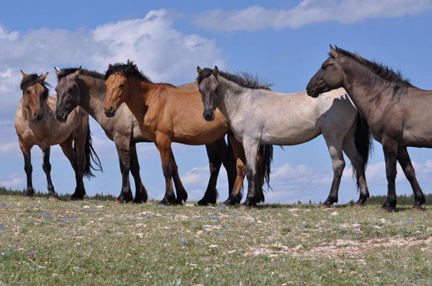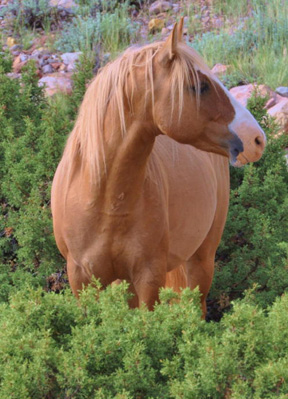|
|
|
|
|
|
|
|
|
Portraits from the Pryor Mountain Wild Horse Range
|
|
|
|

Bachelor Stallions III |
|
by Christine Reed
Horse Photographer
402-672-9227
stillwildhorses@cox.net
For more information or to order photos contact Christine Reed.
|
|
Wild horses inspire people as symbols of freedom. Photographic images of wild horses galloping across the plains appeal to this spirit of the horse. Recently, I had the privilege of spending four days with the wild horses of the Pryor Mountains in Montana, and what moved me was the stillness of the wild horses, although their bursts of energy were exciting to watch.
Band stallions stood watching over their families, being gentle and affectionate with their mares and foals. Mares grazed or nursed their foals. Foals slept often, and wanted to be close to their fathers as well as their mothers. Bachelor stallions, too old to remain in their family bands, hung out together. Family bands coexisted peacefully.
I call this collection of portraits Still Wild because it reflects the stillness and contained energy of wild horses. The other meaning of the title is the sense of a lull before a storm. A number of horses will soon be removed from the range in order to implement the federal governments policy of preventing overpopulaton on the range.
|
|

Harem Stallion: Blizard |
|
|
The images that were on exhibit at the Omaha Healing Arts Center during the August 12th Gallery Crawl reflect a very special story that is a microcosm of what is happening to wild horses across the country. The Pryor Mountain Range in Montana was the first of its kind, established by Secretary of Interior Morris Udall in 1968 in order to protect the wild horses in that area from being removed to make space for livestock ranchers. The Wild Free Roaming Horse and Burro Act of 1971 extended federal government protection to all wild horses on Bureau of Land Management and U.S. Forest Service lands.
Since that time, the federal government’s management of wild horses has been the topic of much controversy, especially its removal of “excess” wild horses by the BLM deemed to be damaging forage and crowding out wildlife species. The BLM now faces a crisis, in some respects of its own making, because there are as many wild horses in short and long term holding facilities as there are on the open range. Wild horse advocates argue that the round-ups are unnecessary. They suspect that the BLM is under pressure from ranchers to make room for more livestock grazing, as well as more leases for natural gas exploration.
Opponents argue that wild horses are an invasive species and that they damage forage as well as compete with indigenous species such as deer, elk and big horn sheep. Horses did evolve on this continent, but became extinct thousands of years ago. In the 16th century, Spanish explorers reintroduced horses and some escaped, joined in later years by loose cavalry and farm/ranch horses. Those who regard wild horses as invasive or “feral” think they ought to be removed from public lands entirely. The Sierra Club, Audubon Society and other environmental organizations agree with this position.
The Pryor Mountain horses are considered unique, because their genetic makeup shows that they are direct descendants of the Spanish horses. Their unique colors and markings are evident from the images in the exhibit. One of the band stallions, “Cloud,” is the star of a series of PBS Nature documentaries. The Pryor herd numbers about 200 horses not counting foals, and the BLM plans to gather 70 or so this fall based on an environmental assessment that the range is being over-grazed.
Some will be adopted, but adoptions have declined in recent years. Internal documents from the George W. Bush administration released through a Freedom of Information Request revealed that the BLM was considering the euthanasia of a large number of wild horses. In addition, a provision that was quietly slipped into the 2004 Appropriations bill allows the sale of “excess” wild horses without limitation - - including slaughter houses. BLM sale contracts currently forbid buyers to sell to slaughter houses.
The cost of caring for wild horses in holding facilities is taking up most of the BLM budget right now, and the federal government is looking for ways to address this crisis. Meanwhile, wild horse advocates argue that the crisis could be solved by returning the horses to the open range and stopping the round-ups. Removals or “gathers” not only create a problem of “disposing” of excess wild horses, but the process is traumatic for family bands if they are separated.
The images in the exhibit, “Still Wild,” reveal a very peaceful coexistence among family bands and deep affection between stallions, mares and their foals. The stillness reflected in these portraits is a moment frozen in time, however, and soon to be disrupted. When I return to the Pryor range next summer, many of the wild horses I knew by name may be gone. The privilege of exhibiting these portraits was therefore a bitter-sweet experience. I have posted two images from the exhibit for this story:
Band of Brothers: Bachelor Stallions
Blizzard: Apricot Dun Harem Stallion
Christine Reed
Horse Photographer
402-672-9227
stillwildhorses@cox.net
|
|
|
|
|
|
|